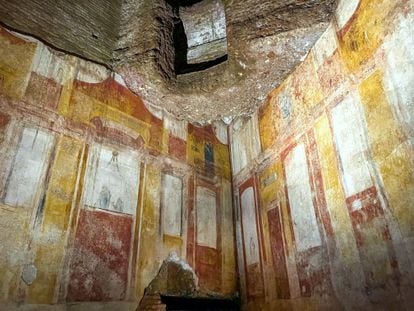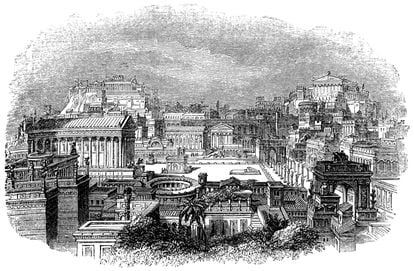/cloudfront-eu-central-1.images.arcpublishing.com/prisa/MDH3KIAHJJA3FODJ6NEQPVUA6A.jpg)
Nero’s Rome was not so different from today’s world: Stratospheric rents, gentrification and chaotic traffic
The historian Dimitri Tilloi-d’Ambrosi has published an essay on daily life in the imperial capital, which was home to a mix of nationalities, exclusive and run-down neighborhoods, and where citizens suffered from noise pollution
In the first century A.D., Rome became the first city with a million inhabitants. Until the 19th century, when Beijing and London achieved the milestone, no other city had reached such a population. Although the temporal and human distance that separates us from classical Rome is enormous — it was an extremely violent world, with slaves and emperors — the urban problems it experienced are repeated throughout the ages. Juvenal (60-128 A.D.) had already warned in his Satires that the cost of buying a sumptuous residence in a village south of Rome was equivalent to the annual rent “of a hovel in the capital.” French historian Dimitri Tilloi-d’Ambrosi picks up this anecdote in his essay 24 heures de la vie sous Néron (originally published in French in 2022 and recently translated to Spanish), in which he describes what distances us, but also what unites us with a world ultimately not so distant: Rome during Nero’s regime.
“Some problems turn out to be quite similar to today,” explains Tilloi-d’Ambrosi, who teaches Roman history courses at the University Paris-Nanterre and the Sorbonne and is the author of a doctoral thesis on food and medicine in ancient Rome, in a videoconference conversation. “There was enormous pressure from the lack of housing and they built higher and higher. The insulae — blocks of apartments — reached five, even six stories, 25 or 30 meters high,” he notes.
Rome, explains the researcher, experienced an intense rural exodus from the first century B.C., at the end of the Republic: many workers left the countryside to settle in the big city. They were landless peasants who lived in very harsh conditions, working for large landowners. “Many decided to leave for the city and we can see how Rome became bigger and bigger, the result of enormous demographic pressure,” says Tilloi-d’Ambrosi. It was a city with sprawling neighborhoods, some of them very undesirable, with housing built in many cases by unscrupulous owners who did not respect even the minimum safety standards. What most worried the emperors were fires, which were devastating, as in the case of the blaze that devastated the city in Nero’s time, in 64 A.D — the emperor was blamed and he in turn, according to a version that many historians question, blamed the Christians — although the image of Nero playing his lyre while Rome burned is completely false.

In Tilloi-d’Ambrosi’s anecdote-packed book are many issues that echo in the present. Although, evidently, the problem of carbon emissions did not exist, regulating traffic in Roman cities was a real nightmare. What today we would call noise pollution was a huge problem, noted by authors such as Seneca. By day, there were monumental traffic jams, so from the time of Julius Caesar, the circulation of carts was restricted during the day for the delivery of goods. “Unfortunately, the clattering of the iron-lined wheels on the cobblestones of the roadway wakes up the neighbors in the middle of the night. Noise disturbances are one of the recurring motifs of satirical or epistolary texts that testify to life in the capital during the imperial era,” writes the researcher.
Throughout the history of Rome, there were also “real phenomena of anticipated gentrification,” writes Tilloi-d’Ambrosi. Although the use of this term may seem anachronistic, if the Oxford Dictionary definition applies — “the process whereby the character of a poor urban area is changed by wealthier people moving in, improving housing, and attracting new businesses, often displacing current inhabitants in the process” — it was exactly what happened on the Aventine. “For centuries, under the Republic, the Aventine is closely associated with the Roman plebs. However, in imperial times, the wealthier social classes settled on this hill and the Aventine then became a neighborhood prized by the elites and abounding in sumptuously decorated luxuries.”
Like the big cities of today, Rome was also a very cosmopolitan capital, where many nationalities, creeds, and languages coexisted. “It was an international city, but so were the ports of Ostia or Lyon,” explains Tilloi-d’Ambrosi. “There were significant Jewish communities, people coming from other parts of the Italian peninsula, and slaves from all over the empire, who formed a very important part of the population. And many Oriental merchants. Syrians, for example, were very famous in antiquity for being great merchants, in the wake of the Phoenicians. We see it in the texts of Juvenal, although he gives a rather distorted view, but also the epigraphy, where many non-Latin names appear. And we also know it from the different cults, Serapis or Mithras. The religions show the cultural blend that took place in Rome and throughout the Empire.

Among all religions, the importance of Christians in Rome during Nero’s reign remains a mystery. The Annals of Tacitus offer one of the best-known fragments of all Latin literature. Some 60 years after the great fire in Rome, the historian related that the emperor held the followers of this new cult responsible. “Nero fastened the guilt and inflicted the most exquisite tortures on a class hated for their abominations, called ‘Chrestians’ by the populace […] Accordingly, an arrest was first made of all who pleaded guilty; then, upon their information, an immense multitude was convicted, not so much of the crime of firing the city, as of hatred against mankind. Mockery of every sort was added to their deaths. Covered with the skins of beasts, they were torn by dogs and perished, or were nailed to crosses, or were doomed to the flames and burnt, to serve as a nightly illumination, when daylight had expired.”
However, in the view of a significant number of historians the chronology does not add up as after Nero’s persecution there were no more attacks against Christians for a century, until the time of the emperor Marcus Aurelius. “They were very much in the minority in Rome at the time of Nero,” explains Tilloi-d’Ambrosi. “These are texts that were copied in the Middle Ages and it is possible that some passages were added then. It certainly happened with Flavius Josephus and the reference to Jesus in his Jewish Antiquities, which must have been much shorter in the original version. The medieval monk copyists added elements of Christian thought, which Josephus could not have formulated. It is not impossible that the same thing happened with Tacitus because, indeed, this persecution of Christians is very isolated in chronology. Until the reign of Marcus Aurelius, in the year 177 in Gaul, there were no significant persecutions. And in the 3rd century it is a phenomenon that develops more and more. The persecution of the year 64 A.D. tends to be questioned and, in any case, it is a very small community. Christians were more numerous in the East and very much in the minority in the West.” Fake news and alternative truths, too, are not only elements of the modern era.

No comments:
Post a Comment